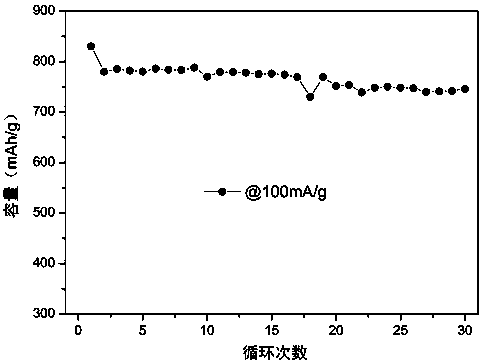A kind of preparation method of lithium battery negative electrode material
A negative electrode material, lithium battery technology, applied in battery electrodes, negative electrodes, secondary batteries, etc., can solve the problems of no coaxial structure, no hollow structure, etc., and achieve the effect of good cycle stability
- Summary
- Abstract
- Description
- Claims
- Application Information
AI Technical Summary
Problems solved by technology
Method used
Image
Examples
Embodiment 1
[0020] SnCl 4 , silica sol, polyvinylidene fluoride by mass ratio m SnCl4 :m 硅溶胶 :m 聚偏氟乙烯 =1:0.4:1.1 Dissolved in ethanol solution, configured as an inner spinning solution with a solid content of 43.2%; dissolved polyvinylpyrrolidone powder in an ethanol solution, configured as an outer spinning solution with a solid content of 18.1%; Put the inner layer spinning solution in the inner layer injector of the coaxial electrospinning equipment, put the outer layer spinning solution in the outer layer injector, and carry out electrospinning according to the parameters of voltage 19kV and receiving distance 26cm, and the same Shaft fiber precursor; sinter the fiber precursor in nitrogen at 750°C for 3 hours to obtain SnO 2 @ / SiO 2 @ / C Composite fiber; soak the composite fiber in 18% HF solution for 20 minutes, wash it repeatedly, and dry it at 100°C for 3 hours to obtain hollow SnO 2 @C nanofibers.
Embodiment 2
[0022] SnCl 4 , silica sol, polyvinylidene fluoride by mass ratio m SnCl4 :m 硅溶胶 :m 聚偏氟乙烯 =1:0.84:1.7 dissolved in ethanol solution, configured as an inner spinning solution with a solid content of 30%; dissolving polyvinylpyrrolidone powder in an ethanol solution, configured as an outer spinning solution with a solid content of 12%; Put the inner layer spinning solution in the inner layer syringe of the coaxial electrospinning equipment, put the outer layer spinning solution in the outer layer syringe, and carry out electrospinning according to the parameters of voltage 16kV and receiving distance 20cm, and the same Shaft fiber precursor; sinter the fiber precursor in nitrogen at 650°C for 5 hours to obtain SnO 2 @ / SiO 2 @ / C Composite fiber; soak the composite fiber in 11% HF solution for 25 minutes, wash it repeatedly, and dry it at 100°C for 5 hours to obtain hollow SnO 2 @C nanofibers.
Embodiment 3
[0024] SnCl 4 , silica sol, polyvinylidene fluoride by mass ratio m SnCl4 :m 硅溶胶 :m 聚偏氟乙烯 =1:2:1.8 dissolved in ethanol solution, configured as an inner spinning solution with a solid content of 28.5%; dissolving polyvinylpyrrolidone powder in an ethanol solution, configured as an outer spinning solution with a solid content of 8.8%; Put the inner layer spinning solution in the inner layer injector of the coaxial electrospinning equipment, put the outer layer spinning solution in the outer layer injector, and carry out electrospinning according to the parameters of voltage 15kV and receiving distance 15cm, and the same Shaft fiber precursor; sinter the fiber precursor in nitrogen at 600°C for 6 hours to obtain SnO 2 @ / SiO 2 @ / C composite fiber; soak the composite fiber in 5% HF solution for 45 minutes, wash it repeatedly, and dry it at 100°C for 10 hours to obtain hollow SnO 2 @C nanofibers.
PUM
| Property | Measurement | Unit |
|---|---|---|
| quality score | aaaaa | aaaaa |
Abstract
Description
Claims
Application Information
 Login to View More
Login to View More - R&D
- Intellectual Property
- Life Sciences
- Materials
- Tech Scout
- Unparalleled Data Quality
- Higher Quality Content
- 60% Fewer Hallucinations
Browse by: Latest US Patents, China's latest patents, Technical Efficacy Thesaurus, Application Domain, Technology Topic, Popular Technical Reports.
© 2025 PatSnap. All rights reserved.Legal|Privacy policy|Modern Slavery Act Transparency Statement|Sitemap|About US| Contact US: help@patsnap.com

